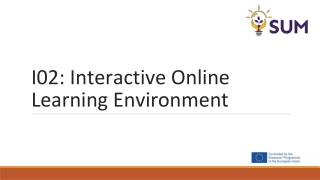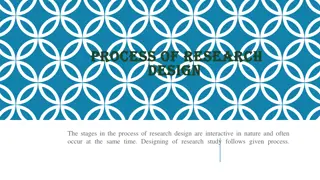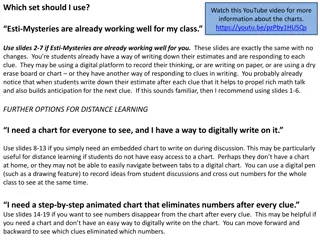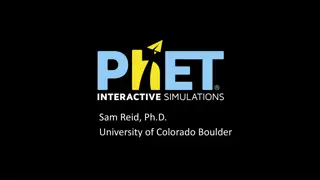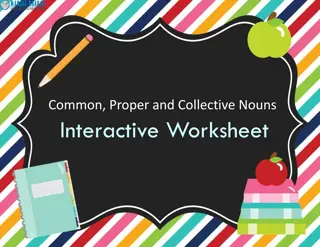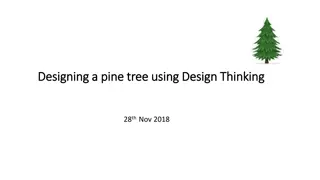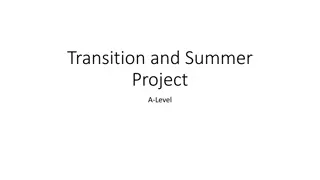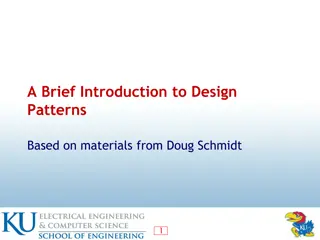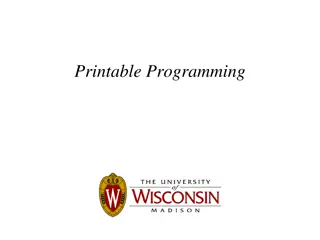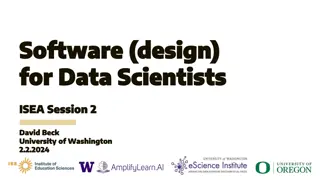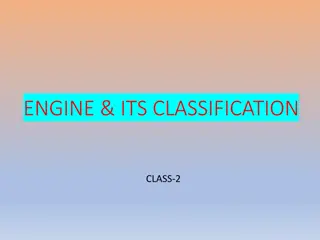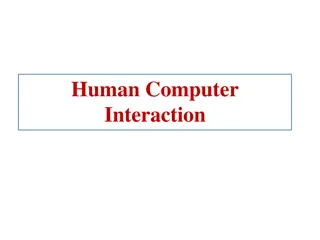I02: Interactive Online Learning Environment
Explore the IO2 interactive online learning environment, which focuses on delivering all online learning components and tools. The methodology includes an interactive learning platform, development and integration of learning tools, communication tools, and a mobile application. Dive into the IO2 le
1 views • 8 slides
Understand the Process, Stages, and Types of Research Design
The process of research design involves interactive stages that occur simultaneously, leading to the classification of research design into exploratory, descriptive, and experimental types. Each type serves a unique aim, from understanding problems to testing hypotheses through structured experiment
4 views • 8 slides
Software Analysis and Design Process
Software analysis and design involve a systematic approach to understanding user requirements, creating logical models, and transitioning to detailed design specifications. Requirements analysis focuses on capturing system requirements, while design translates these requirements into implementation
8 views • 16 slides
The Process and Types of Research Design
The process of research design involves interactive stages that occur simultaneously, leading to the designing of a research study. This includes steps in research design, classification of research design types, such as exploratory, descriptive, and experimental/causal research design. Each type se
12 views • 8 slides
5 Advantages of Interactive Touchscreen Displays
Techno Edge Systems LLC offers cutting-edge displays with five key advantages. Enhance engagement with interactive content, promote collaboration, improve presentations, streamline information access, and create memorable experiences. Interactive Touch Screen Rental in Dubai. Contact us at 054-4653
3 views • 8 slides
Interactive Esti-Mystery Chart Activity for Classroom Engagement
Engage your class with interactive Esti-Mystery charts to enhance math skills through estimation and deduction. Choose from different sets based on your classroom needs for in-person or distance learning. The activity involves narrowing down possibilities based on clues provided as students estimate
1 views • 19 slides
Guidelines for Design of Cement Concrete Pavement and Interlocking Paver Blocks
This document provides guidelines for designing cement concrete pavements and interlocking paver blocks, covering factors governing design, wheel loads, design period, subgrade characteristics, approximate k values based on CBR values, and the importance of a sub-base below concrete pavements. It em
0 views • 67 slides
Interactive Plotting with ggplot and Shiny: Enhancing Galaxy Visualization Tools
Explore the concept of transforming existing ggplot2 Galaxy tools into interactive platforms using Shiny or Plotly implementations. Discover a variety of plot types available with ggplot2, such as barplots, violin plots, PCA plots, and heatmaps. Utilize additional plot options through various geom_*
3 views • 9 slides
Software Engineering Design Principles and Concepts
The chapter discusses the essential principles and concepts in software design, highlighting the four key design models - data design, architectural design, interface design, and component-level design. It emphasizes the importance of traceability to the analysis model, minimizing the gap between so
2 views • 36 slides
Human-Centered Design in ISO 9241-210 by Albrecht Schmidt
Explore the differences between User-Centered Design (UCD) and Human-Centered Design (HCD) as per ISO 9241-210 standards. Delve into the principles and activities of HCD, the rationale for adopting it, and its significance within interactive systems. Learn why HCD emphasizes the holistic perspective
0 views • 17 slides
Insights on Interactive Narrative and New Media
Discussion on the evolution of interactive narrative and new media, highlighting Janet Murray's work, the complementary skills of hackers and bards, the concept of the Holodeck as a universal fantasy machine, Janeway's Holonovel, and the early reactions to new media technologies. Topics covered incl
0 views • 22 slides
Interactive Science Simulations by PhET - Engaging Learning Experiences
Explore PhET Interactive Simulations founded by Nobel Prize physicist Carl Wieman, offering over 120 interactive simulations across various scientific disciplines. From Energy Skate Park to Molecule Shapes, these simulations provide engaging, game-like experiences for students and scientists alike.
0 views • 13 slides
Learn About Common, Proper, and Collective Nouns with Interactive Worksheet
Explore the differences between common, proper, and collective nouns through an interactive worksheet. Discover how each type of noun names people, places, or things, and test your understanding with engaging activities. Dive into the world of nouns and enhance your language skills in an interactive
0 views • 74 slides
Interactive Design Workshop: Pine Tree Creation Using Design Thinking
Join us in an engaging design workshop where you will learn the principles of Design Thinking by drawing a pine tree on a Cartesian plane. Through activities like warming up, empathizing, ideating, defining, and prototyping, you will enhance your collaborative problem-solving skills while creating i
0 views • 14 slides
System on Chip (SoC) Design and Components
Explore the world of System on Chip (SoC) design, components, and working flow. Learn about Intellectual Properties (IP), platform-based design, typical design flows, top-down design approach, and the emerging Electronic System Level (ESL) design flow. Discover the essential components of an SoC, su
0 views • 45 slides
Design Inspiration and Elements in Costume and Fashion Design
Dive into the world of costume and fashion design through a visual journey of finding design inspiration, understanding the design process, emphasizing originality, and exploring different sources of creativity. Discover how technology, art, food, history, architecture, and nature can spark innovati
0 views • 45 slides
Enhancing Piping Design Efficiency with Spec-Driven Technology
Explore how Spec-Driven Piping technology powered by CADACTIVE offers a standardized approach for piping design in Creo Parametric. This innovative extension streamlines design communication, eliminates errors, and improves design efficiency by utilizing a master catalog, automated checking capabili
0 views • 15 slides
Efficient Interactive Proof Systems Overview
This document discusses various aspects of efficient interactive proof systems, including doubly efficient IPs, simple doubly efficient IPs, and the Sum-Check Protocol. It explains concepts such as completeness, soundness, and strategies for verifiers and provers. The content covers examples like NP
0 views • 12 slides
Creating Interactive Reports Using Excel Pivot Tables - Guide by Brandon Aragon
Learn how to create interactive reports using Excel pivot tables with this comprehensive guide by Brandon Aragon, Research Technician at CSUSB. Explore topics such as preparing data, using the Pivot Table Wizard, and enhancing decision-making through data analysis and reporting. Discover the benefit
0 views • 25 slides
Material Design: Combining Classic Design Principles with Technological Innovation
Material Design is a design language that combines traditional design principles with the possibilities offered by technology and science. It emphasizes visual language, classic design elements, and innovation to create delightful user experiences. The Material Metaphor, Imagery, Typography, Color,
0 views • 34 slides
Comprehensive Guide to System Design Components and Techniques
System design involves the detailed planning and identification of components in an information system, aiming to provide users with a general understanding of the new system. This process includes techniques like flowcharts, prototyping, and component design, covering aspects such as output design,
0 views • 24 slides
Design Patterns: A Comprehensive Overview
Exploring the world of design patterns, this content delves into the essence of design patterns, their application in software design to resolve complexity, and the different types of design patterns - creational, structural, and behavioral. It also showcases examples of popular design patterns such
0 views • 22 slides
The Influence of Words on Sound Recognition in Interactive and Non-interactive Models
Influence of words on sound recognition differs in interactive and non-interactive models. In interactive models, sounds activate words in the mind in a feedback loop, while in non-interactive models, two routes exist to recognize a sound, one through words and the other directly through sounds. Thi
1 views • 6 slides
Basic Concepts in Software Design
Software design involves transforming customer requirements into a form suitable for implementation, with activities categorized into preliminary and detailed design stages. High-level design focuses on module identification and control relationships, while detailed design entails defining data stru
1 views • 24 slides
The Impact of Interactive Teaching on Conceptual Development in Physics
Investigating the effectiveness of interactive teaching in promoting conceptual development in physics, focusing on student learning in both conventional and interactive classrooms. Research examines student understanding through qualitative reasoning questions, such as the baseball bat scenario, to
0 views • 62 slides
Interactive Time Bingo Game for Learning English
Engage students in a fun and educational way with the Interactive Time Bingo Game. Using two stacks of cards, students practice asking and answering questions about daily routines and activities related to specific times. The game encourages speaking and writing skills as they create sentences based
0 views • 14 slides
Advancements in Interactive Proofs for Efficient Computation
Recent developments in interactive proofs focus on enhancing the efficiency of computations outsourced to untrusted servers, addressing concerns related to correctness and privacy. Solutions like doubly efficient interactive proofs offer a secure way to delegate computations while minimizing relianc
0 views • 25 slides
3D Design and Critical Analysis in Architecture
Dive into the world of 3D design and critical analysis with a focus on architecture. Discover the stages of design, essential skills for designers, and areas of study in three-dimensional design. Delve into iconic buildings like Frank Lloyd Wright's Falling Water, analyze their key features, and eve
0 views • 9 slides
Constant Round Interactive Proofs for Delegating Computations
The research explores techniques for securely delegating computations to the cloud, addressing concerns of correctness and privacy through interactive proofs and efficient verification methods. It compares classical and doubly efficient interactive proofs, emphasizing the importance of computational
0 views • 43 slides
Design Patterns in Object-Oriented Design
Design patterns in object-oriented design (OOD) are essential templates that codify best practices for solving common problems. They help streamline development by capturing proven design decisions, promoting code reuse, and enhancing system flexibility and modularity. Learn about the core concepts,
0 views • 20 slides
Interaction Design in Human-Computer Interaction
Interaction design focuses on creating interactive products that are easy, effective, and enjoyable to use. It aims to reduce negative user experiences while enhancing positive ones. Designing interactive products requires understanding user activities, interfaces, and device arrangements to support
0 views • 11 slides
SE2811 Software Component Design Overview
This course covers software component design, design patterns, object-oriented design, algorithms, and opportunities for reuse in systems design. It emphasizes the importance of domain-level design and provides insights into solving core problems through reusable classes.
1 views • 21 slides
Interactive 3D Printing and Programming Course
Deep dive into the world of 3D design and programming with an interactive course that covers visual thinking, programming basics, project presentations, and CADjs. No prior programming experience required. Learn to create 3D models, manipulate shapes, and understand the process from design to 3D pri
0 views • 13 slides
Analysis of Bunch Lengthening in CEPC for Different Design Parameters
This study explores bunch lengthening in the Circular Electron Positron Collider (CEPC) for various design parameters, analyzing a 54 km design scheme, a 61 km design scheme, and a 100 km design scheme. The analysis includes the theoretical framework used, equations for bunch lengthening, and conclu
1 views • 15 slides
Plain & Reinforced Concrete Structures in Design Engineering
In the design of Plain & Reinforced Concrete structures, various strength design methods such as Ultimate Strength Design (USD) and Allowable Strength Design (ASD) are utilized. These methods involve factors of safety, material strength, load factors, and analysis in the elastic range. Additionally,
0 views • 11 slides
Verilog Adder Examples & Typical IC Design Flow
This comprehensive content delves into Verilog adder examples, typical IC design flow, physical design considerations, and examples of OpenGL ES GPU and ARM hypervisor applications. It covers the fundamentals of digital logic with Verilog design, hardware description language, FPGA prototyping, phys
1 views • 27 slides
The Importance of Software Design for Data Scientists
Today's ISEA Session 2 with David Beck from the University of Washington delves into the critical role of intentional software design for data scientists. The session covers the software design approach, user-centric design stories, use cases, components, testing strategies, and the benefits and dra
1 views • 76 slides
Engine Classification and Design
Engine classification involves categorizing engines based on various factors such as combustion type, number of strokes, cylinder design, and ignition method. Common classifications include external and internal combustion engines, as well as categories based on the design and use of the engine. Add
0 views • 11 slides
Prototyping in Human-Computer Interaction
Design activities in Human-Computer Interaction involve iterative processes of prototyping and evaluation to create user-centric interactive products. Prototyping allows stakeholders to interact with and explore the design's suitability, serving various purposes like testing feasibility, clarifying
0 views • 7 slides
Interactive Proofs in Complexity Theory
Delve into the realm of interactive proofs in complexity theory, exploring concepts such as completeness, soundness, and efficiency. Discover how interactive proof systems can be utilized in scenarios like graph isomorphism and their implications on the complexity classes NP and coNP. Uncover the in
0 views • 40 slides
